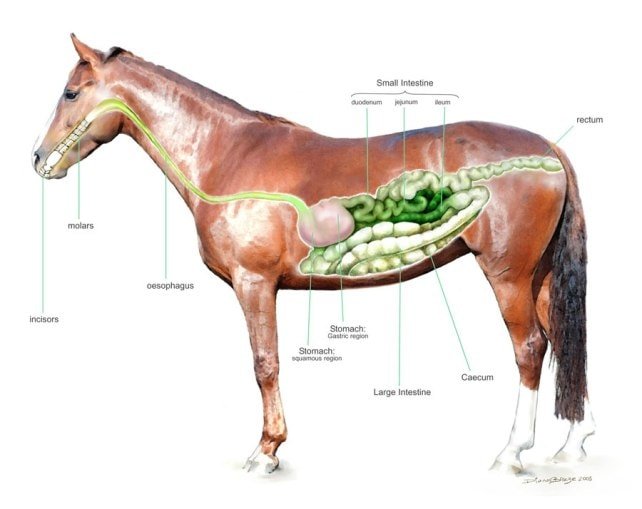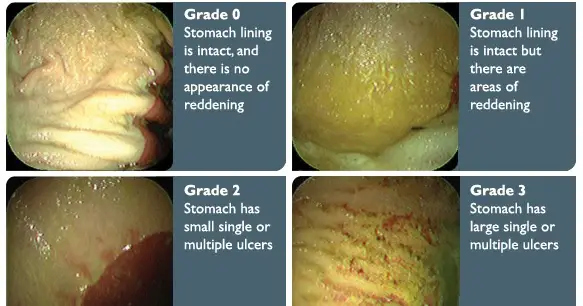EGUS, or Equine Gastric Ulcer Syndrome, is the term used to describe ulcerative and erosive diseases of the stomach of horses. This is a common problem for all breeds and age groups of horses. The ulcers are the erosive wounds lining the gastric mucosa of horses. There are two types of Equine Gastric ulcers; Equine Squamous Gastric Disease (ESGD) and Equine Glandular Gastric Disease (EGGD).
Importance of Equine Gastric Ulcer Syndrome
The horse is a single-stomach animal, and the stomach has two distinct parts; glandular and non-glandular. The glandular part produces hydrochloric acid (HCl) that maintains the pH of the stomach. The irregularities of feeding, stress, and faulty management change the stomach environment and cause gastric ulcers.
What causes EGUS?
Equine gastric ulcer is a complicated disease and results from many causes. The primary causes of gastric ulcers in horses are as follows:
1. Irregular Feeding or Fasting.
Irregular feeding, intermittent feeding, and fasting irritate the gastric mucosa. Horses stomach is glandular, and an empty stomach is vulnerable to acidic erosion. The mucosa exposed to excessive acid released during fasting or incomplete feeding causes erosion to glandular mucosa.
2. High Concentrate on Diet.
Excessive concentrate in horse diet fermented in the stomach and produced volatile fatty acids (VFA). This VFA enters the squamous cell that swells and dies. The death of squamous cells leads to ulceration.
3. Sudden Excessive Exercise
Over-exercise suddenly causes stomach compression, and the stomach’s upper part is exposed to acid. The horses are in intensive training and continuously exposed to acids in the squamous lining, leading to ulceration of gastric mucosa.
4. Delayed Gastric Emptying
Anything that causes delayed gastric emptying leads to Equine gastric ulcer syndrome. In foals, the desquamation of gastric lining at the age of 35-40 days. Obstruction of duodenal outflow is common in neonatal foal.
5. Housing/ Stabled Horses
Gastric ulcers are less common in horses who can graze at their leisure. The stabled horses are more vulnerable to gastric ulcer syndrome. A study showed that horses brought to the stable from pasture were affected by gastric ulcers within 24 hours.
6. Trailering Horse
Horses engaged in trail riding, transportation, and endurance riding are more stressed. The horses’ are given less hay and more concentrated feed in their diet. Stressed horses produce more cortisone, inhibiting blood flow to the stomach and leading to ulceration.
7. Use of Non-steroidal Inti-inflammatory Drugs (NSAIDs)
NSAIDs are very notorious drugs that cause gastric ulcers in all species. NSAIDs produce prostaglandins, decrease blood flow to the stomach, and decrease mucous production.
Risk Factors of Gastric Ulcer Syndrome in Horses
The prevalence of Equine gastric ulcers in active and performance horses is 19-93%. The risk factors are as follows:
- The intensity of horse training.
- Feeding behavior.
- Horse Stable or accommodation environment.
- The number of days in training in a week.
- Presence or absence of direct contact with other horses.
- Diet and feeding management.
- Access to free grazing.
- Watering management.
- Presence of bedding.
Clinical Signs of Equine Gastric Ulcer Syndrome
Horses affected with gastric ulcers show various clinical signs. The clinical manifestations range from off-feed to severe colic. The typical clinical signs are as follows:
- Lack of appetite.
- Poor body condition.
- Picky eating.
- Dull hair coat.
- Chronic diarrhea.
- Changing of behavior; nervousness or aggression.
- Teeth grinding.
- Acute or recurrent colic.
- Discomfort or pain during eating.
- Poor performance.
- Decrease ability in training.
- Chronic loss of body weight.
How is EGUS diagnosed?
The clinical signs of gastric ulcers are confusing, but the diagnosis is straightforward. The diagnostic methods are as follows:
- Clinical history and presence of risk factors.
- Clinical signs.
- Endoscopy of esophagus and stomach.
- Total blood count for cortisone.
The horse should be sedated before the endoscopy. There are four types of gastric ulcers graded from zero to three:
- 0-No definitive lesions
- 1-There is a slight single to few mild lesions on the gastric mucosa.
- 2- Medium sized multiple lesions present.
- 3- Deep and extensive coalescence ulcers present with bleeding.
How is EGUS Treated?
Treatment of gastric ulcers in horses aims to restore the gastric mucosa and reduce the causes. The line of treatments for EGUS is as follows:
- You can use an omeprazole tablet once daily for 30 days. Omeprazole is a proton pump inhibitor that reduces acid production by the gastric mucosa.
- You can use Renitidin, which is Type-2 histamine (H2) blocker. Histamines are naturally occurring chemicals responsible for acid production in the stomach.
- You can increase protein and roughage in the horse diet to balance acids in the stomach.
- Additional feeding of calcium with a regular diet.
Prevention of Equine Gastric Ulcer Syndrome
We learned the principal causes and clinical signs of gastric ulcers in horses. Prevention is the best way to reduce the incidence of gastric ulcers in equine. My preventive measures are as follows:
- Reduce the amount of concentrate feed in horse ration.
- Allow the horses to the pasture freely.
- Reduce stress in horses as much as possible.
- Maintain a regular feeding schedule for your horse.
- Never go for overtraining or exercise.
Final Advice on EGUS
Equine gastric ulcer is a common problem in all age groups and breeds of horses. The major causes of the disease are faulty feeding management and stress. The condition is aggravated if you do not start treatment early. The horse may die due to severe colic, intestinal obstruction, or volvulus.
This article will help you with better horse management and save your dearest animal’s life. If the article is helpful, please share it with your friends who have horses.
You can visit my website to learn more about horse breeds, diseases, management, etc.

